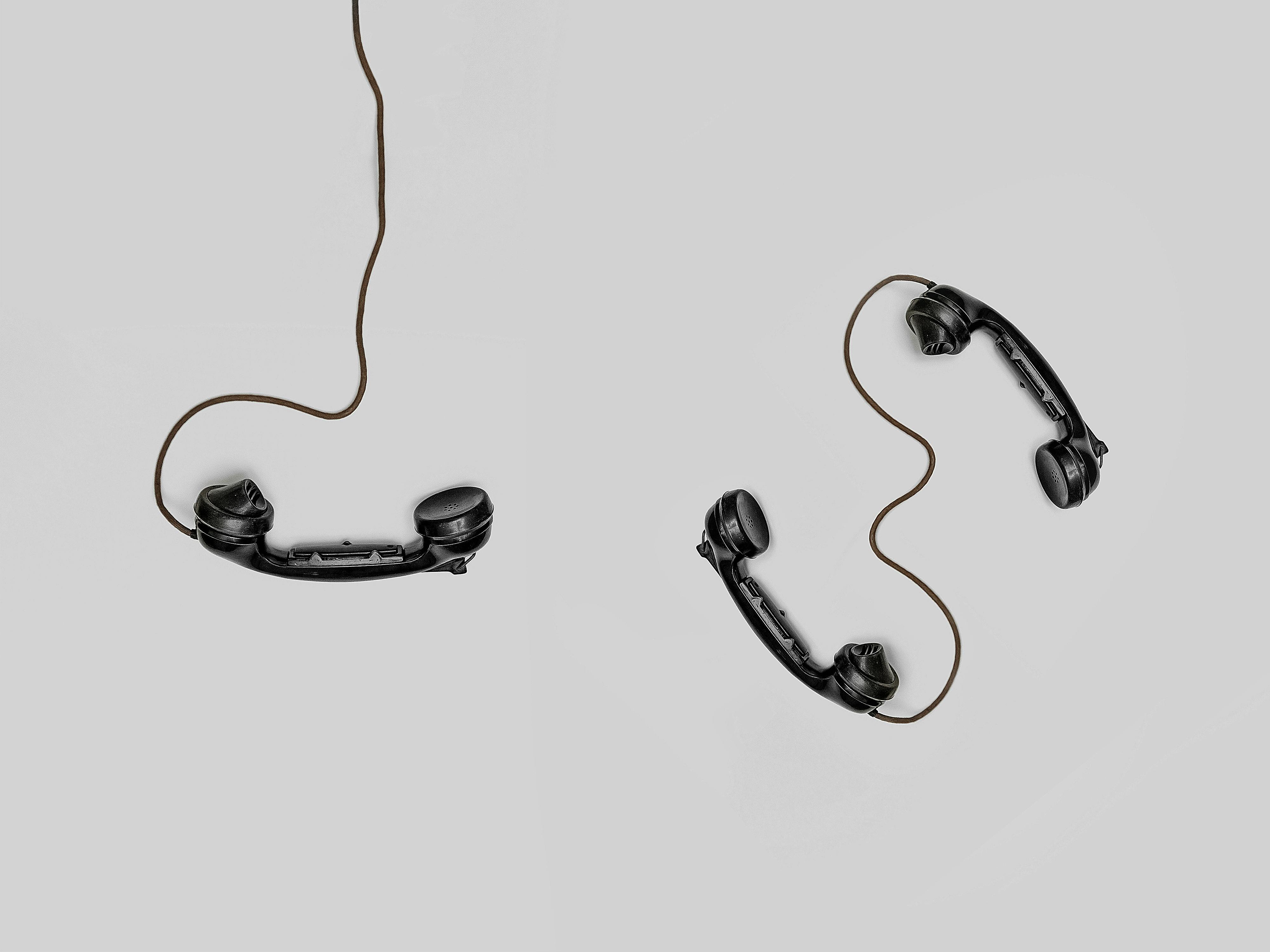- What is Interview Analysis?
- Advantages of Interviews in Research
- Disadvantages of Interviews in Research
- Ethical Considerations in Interviews
- Preparing a Research Interview
- Recruitment & Sampling for Research Interviews
- Interview Design
- How to Formulate Interview Questions
- Rapport in Interviews
- Social Desirability Bias
- Interviewer Effect
- Types of Research Interviews
- Face-to-Face Interviews
- Focus Group Interviews
- Email Interviews
- Telephone Interviews
- Stimulated Recall Interviews
- Interviews vs. Surveys
- Interviews vs Questionnaires
- Interviews and Interrogations
- How to Transcribe Interviews?
- Verbatim Transcription
- Clean Interview Transcriptions
- Manual Interview Transcription
- Automated Interview Transcription
- How to Annotate Research Interviews?
- Formatting and Anonymizing Interviews
- Analyzing Interviews
- Coding Interviews
- Reporting & Presenting Interview Findings
- How to cite "The Guide to Interview Analysis"
Telephone Interviews
Unlike in-person interviews, which often require logistical planning and travel, telephone interviews offer an opportunity to reach participants across geographical boundaries, enabling researchers to gather diverse perspectives. It's important to weigh the advantages and limitations of telephone interviews and understand how they fit within the broader spectrum of qualitative data collection methods. This article delves into the advantages and challenges of conducting telephone interviews and provides a guide for effectively executing them.

Introduction
Telephone interviews provide a unique opportunity for qualitative researchers to access participants who may be difficult to reach through in-person methods. This is especially relevant in areas like social science, public health, and clinical nursing research, where researchers often need to gather data from diverse populations scattered across different locations. By removing the need for physical presence, telephone interviews allow researchers to expand their recruitment pool, engage with participants from remote or rural areas, and collect data from individuals with mobility limitations or other health-related constraints.
In addition to their logistical advantages, telephone interviews are a cost-effective alternative to in-person interviews, eliminating the expenses associated with travel, venue booking, and equipment. For market research, where time and resources are often limited, telephone surveys and interviews offer a streamlined approach to gathering consumer insights across large geographic areas without incurring significant costs. This method is well-suited to exploratory studies where rapid data collection is required to guide decision-making.
However, conducting qualitative research over the phone requires careful consideration of the challenges that arise in the absence of face-to-face interaction. The lack of non-verbal cues, such as body language and facial expressions, presents a unique challenge for interviewers who rely on these signals to gauge participant emotions, hesitations, or enthusiasm. Establishing rapport and trust over the phone can also be more difficult, especially when discussing sensitive or personal topics. As a result, researchers must adapt their techniques to compensate for these limitations and ensure the quality of the data collected remains high.
Advantages of phone interviews over other interview methods
Phone interviews offer several unique advantages over other interview methods, such as face-to-face interviews, online surveys, and web-based interviews. One of the key benefits is their flexibility, as researchers can easily arrange calls to suit both the interviewer and participant's schedules. This flexibility makes telephone interviews particularly useful for recruiting participants from different regions or those unable to meet in person.
Telephone interviews also reduce logistical costs, eliminating the need for travel or venue arrangements. For market research and exploratory qualitative research, this is especially beneficial, as companies can conduct telephone surveys or interviews to gather insights without the financial burden of in-person data collection. Businesses conducting market research frequently use phone surveys to gather consumer feedback across regions, speeding up the data collection process.
Another advantage lies in the perceived anonymity of phone interviews. Participants often feel less scrutinized when not physically present, which can encourage openness, especially when discussing sensitive topics. In research studies focused on mental health or personal issues, participants may find it easier to disclose details over the phone than in person.
Telephone interviews can also be less prone to interviewer bias. In face-to-face interviews, subtle non-verbal cues, such as facial expressions or body language, can unintentionally influence participant responses. Telephone calls remove visual cues, allowing the focus to remain purely on verbal content.
Lastly, telephone interviews offer a faster alternative to in-person interviews, reducing the time needed fordata collection. For projects where timelines may be tight, telephone interviews can speed up the research process, ensuring timely results while maintaining data quality.

Challenges in phone interviews
Despite their many advantages, phone interviews also come with inherent challenges. While in some cases it can be an advantage, one major limitation is the lack of non-verbal communication, such as body language and facial expressions. These visual cues often help interviewers assess participants' emotions or reactions, providing a deeper understanding of their responses. In phone interviews, researchers must rely solely on verbal responses, which can sometimes lead to incomplete data interpretations. For instance, in a study on patient experiences in healthcare settings, face-to-face encounters might reveal subtle discomfort through body language, which a telephone interview would miss.
Another challenge is establishing rapport with participants. In in-person interviews, the physical presence of the interviewer helps create a personal connection, which fosters trust and encourages participants to share more openly. Over the phone, researchers must work harder to develop rapport through tone of voice, active listening, and empathy. This can be particularly challenging when discussing sensitive topics, where the physical distance might make participants feel disconnected from the interview process.
Telephone interviews can also lead to lower data quality in some cases. Some researchers have noted that participants tend to give shorter, less detailed responses during phone interviews compared to in-person interviews. This may be due to the lack of visual interaction or the nature of the phone call, which participants may perceive as less formal. Moreover, without non-verbal feedback, interviewers might struggle to probe effectively, missing opportunities to explore key themes or topics in greater depth.
The absence of visual cues can also lead to difficulties interpreting emotions or gauging when a participant is hesitant or confused. Skilled interviewers can sometimes mitigate this by paying close attention to verbal cues such as pauses, tone shifts, or changes in pace, but this requires training and experience. For instance, in qualitative research interviews exploring personal identity or trauma, missing such nuances could result in data that lacks depth.
Additionally, response rates for telephone interviews can sometimes be lower than for other methods, particularly when compared to face-to-face or internet-based interviews. Potential participants may be less inclined to commit to a phone interview, perceiving it as more intrusive or time-consuming. Qualitative researchers often face challenges in recruiting participants for such interviews, especially in studies requiring a diverse sample.
Interviewers may also face technical difficulties such as poor audio that can lead to misunderstanding answers or losing signal during an interview if the interviewee is in a remote location. These technical difficulties can be avoided by planning and having a backup plan in case any technical issue arises.

Conducting a phone interview requires careful planning, preparation, and skilled interviewing techniques to maximize data quality. The following steps provide a guide for researchers looking to conduct effective telephone interviews:
Preparation
Begin by thoroughly researching the participant demographic and tailoring your questions accordingly. Ensure that your interview questions align with the research objectives and are designed to elicit in-depth responses. For example, in a study exploring patient satisfaction in clinical nursing research, questions should focus on the qualitative aspects of patient experiences rather than quantitative measures.
Develop rapport
Establishing rapport is crucial, particularly over the phone where visual interaction is absent. Begin the interview with an introduction that explains the purpose of the research and emphasizes the participant's valuable role. Use a warm and friendly tone to make participants feel comfortable. As the interview progresses, continue to actively listen and respond to the participant’s answers to maintain a conversational flow.
Active listening and follow-up questions
Active listening is key to successful phone interviews. Pay close attention to the participant's tone and wording, as these are the only cues available to gauge their emotions or hesitations. Use probing questions or clarifications to dive deeper into their responses. For instance, in social science research, where exploring cultural beliefs or social behaviours is important, asking follow-up questions helps uncover underlying themes or contextual data.
Minimize distractions
Conduct interviews in a quiet environment where external noises won’t interfere with the conversation. Inform participants in advance that the interview will be conducted via phone, and encourage them to find a quiet and private location for the call. Distractions on either end can interrupt the flow of the conversation and impact the depth of data collected.
Record and take detailed notes
Recording telephone interviews (with participant consent) ensures accuracy during data analysis. In addition, take detailed research notes during the interview, capturing key points and any verbal cues that may indicate emotion or emphasis. These notes are invaluable for contextualizing responses later during the qualitative analysis phase. For instance, in qualitative research interviews on workplace dynamics, certain themes may only become apparent when reviewing these notes in detail.
Build in time for probing
Unlike in-person interviews, probing during phone interviews requires extra effort since verbal cues are all that are available. Build extra time into your interview schedule for follow-up questions to clarify or expand on participant responses.
Conclude thoughtfully
At the end of the interview, thank the participant for their time and contributions. Summarize key points to confirm your understanding and allow them to clarify or add further information. Include closing questions such as "Is there anything else you want to add?" to make sure the participant has expressed everything they want to express. These closing questions may give insights into information that is important but was overlooked. They also make the participants feel heard.
Conclusion
Telephone interviews offer a flexible, cost-effective method for collecting qualitative data, making them a valuable tool in qualitative research. Despite the challenges of building rapport and navigating the absence of non-verbal cues, skilled interviewers can leverage active listening, thoughtful questioning, and careful preparation to gather rich data through this method. By understanding the strengths and limitations of telephone interviews, qualitative researchers can push methodological boundaries and expand the research scope, reaching diverse participants across different contexts. Whether exploring sensitive topics, conducting market research, or engaging in health studies, telephone interviews remain a practical and insightful approach in the qualitative research toolkit.




